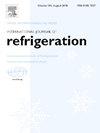Experimental retrofit of an R404A/R23 ultra-low temperature freezer using R448A and electronic expansion valves
IF 3.5
2区 工程技术
Q1 ENGINEERING, MECHANICAL
International Journal of Refrigeration-revue Internationale Du Froid
Pub Date : 2025-01-16
DOI:10.1016/j.ijrefrig.2025.01.017
引用次数: 0
Abstract
The lack of regulations that limit the GWP of refrigerants operating in vapour compression systems with a target temperature below –50°C has caused slower market development. Therefore, limited refrigerants and technologies for ultra-low temperature (ULT) refrigeration have been studied. In this work, an experimental assessment of R448A as a lower-GWP alternative to R404A in the high-temperature stage of a ULT two-stage cascade refrigeration system is done using R23 as the low-temperature stage refrigerant. Furthermore, capillary tubes and electronic expansion valves are compared as expansion devices. First, the pull-down performance starting from three room temperatures (15, 20, and 25°C) down to –80°C is analysed. Then, the hysteresis operation with those ambient temperatures and set freezer temperatures of –80, –70, –60, and –50°C is studied. The pull-down time was higher (38 to 55 min slower) using the capillary tubes compared to the electronic expansion valves. Also, the energy consumption of the hysteresis operation was higher (up to 32.3% higher) using the capillary tubes. The electronic expansion valves obtained comparable energy consumption and cooling capacity with R404A/R23 and R448A/R23. The highest COP is achieved by R448A/R23 (up to 10.2% higher than R404A/R23). Therefore, the suitability of R448A as a replacement for R404A in ULT refrigeration is confirmed.
求助全文
约1分钟内获得全文
求助全文
来源期刊
CiteScore
7.30
自引率
12.80%
发文量
363
审稿时长
3.7 months
期刊介绍:
The International Journal of Refrigeration is published for the International Institute of Refrigeration (IIR) by Elsevier. It is essential reading for all those wishing to keep abreast of research and industrial news in refrigeration, air conditioning and associated fields. This is particularly important in these times of rapid introduction of alternative refrigerants and the emergence of new technology. The journal has published special issues on alternative refrigerants and novel topics in the field of boiling, condensation, heat pumps, food refrigeration, carbon dioxide, ammonia, hydrocarbons, magnetic refrigeration at room temperature, sorptive cooling, phase change materials and slurries, ejector technology, compressors, and solar cooling.
As well as original research papers the International Journal of Refrigeration also includes review articles, papers presented at IIR conferences, short reports and letters describing preliminary results and experimental details, and letters to the Editor on recent areas of discussion and controversy. Other features include forthcoming events, conference reports and book reviews.
Papers are published in either English or French with the IIR news section in both languages.

 求助内容:
求助内容: 应助结果提醒方式:
应助结果提醒方式:


